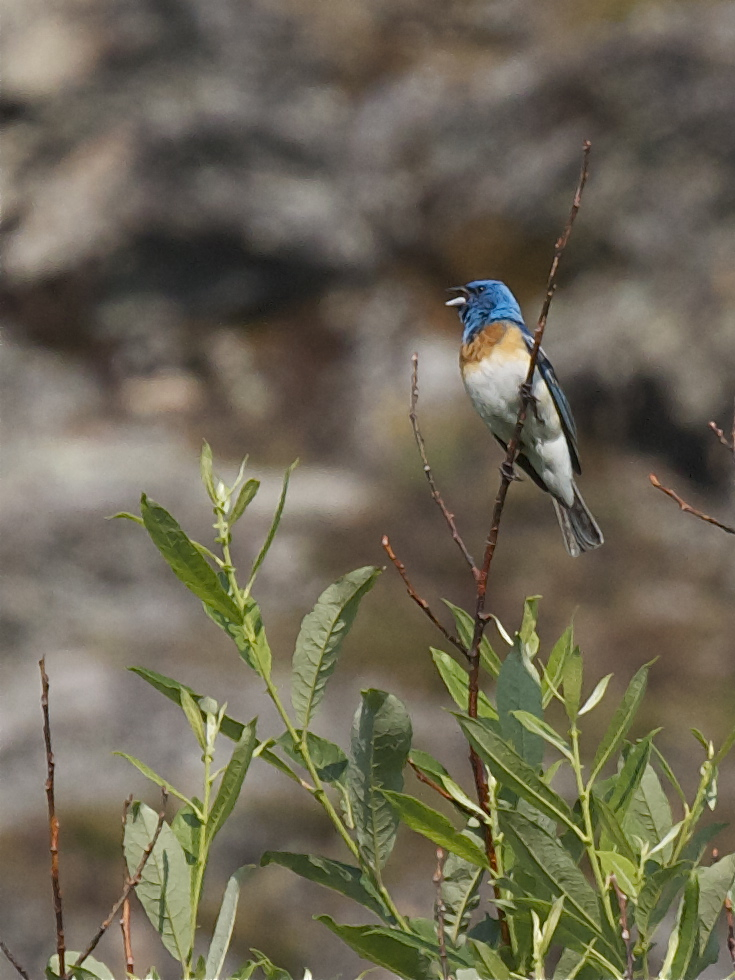I could write for almost 30 years on this topic. I started researching White-tailed Ptarmigans as a young, young fella working on my Ph.D. in Zoology at Washington State University. Initially, my project was looking at territorial aggression. I was going to watch for agonistic interactions among males and see if their frequency had any relationship with how closely related the two individuals were. My thought was that perhaps they are less aggressive toward their own kin.
Writing this is embarrassing. Not because the theory is necessarily unlikely. But because of how impossible it would be to collect the data. Not only did I need to see male ptarmigan fighting with each other. I also needed to know genetic relationships. That’s not easy. Even harder in the 1990s.
But! Day one of my Ph.D. field work in June of 1995, I was up at Logan Pass looking for Ptarmigan and I found a male! I had never seen one before in my life! How cool. Next I needed to catch him so I could put bands on his legs. This proved to be more difficult than I expected and the bird ended up flying away across a creek. And, just like that, another male on the other side of the creek attacked! They started chasing each other through the air and screaming their flight screams all the while. Then they landed right in front of me and were cackling and chasing each other around. It was amazing. It was exactly the type of behavior I was looking for.
It was the only time in almost 30 years I’ve seen this behavior!
So, the project in the 1990s morphed into a look at mating system and habitat use. Since then I’ve been examining how changing climate is impacting the Ptarmies at Logan Pass. And it seems to be: their population has declined substantially since the 1990s and they are breeding and flocking higher on the study area than they used to. I’ll write more about it at some point.
White-tailed Ptarmigans are the only bird species in North America to spend their entire lives in the Alpine, up above the trees. That is where you will find them – even in winter. That makes them hard to find in Glacier until the high passes melt out enough to get up there. Logan pass used to be the best place to see them. Now there are far fewer ptarmigan living on Logan and far more people and restrictions on off-trail travel.
Logan Pass
It’s still possible to find ptarmigan on Logan Pass if you go right after the Going-to the-Sun Road opens in June. Usually you are allowed to walk off trail at that point because the trail and most of the area you can see is under snow. Look for small rocky outcrops with young growing vegetation. Those are good spots for breeding males (and sometimes females) to hang out in June and early July. If you do this, please stay off the vegetation. Keep your feet on the snow or rock where you won’t be crushing ptarmigan habitat and their food sources.
Those rocky outcrops that are the first to melt out of the snow are the best places to look in June and early July. Late July through August, you want to look for the places in the high alpine that are the lushest green. They’ll be wet, rocky, mossy, with super-young vegetation usually near a late-lying snow field. Ptarmigan need these places to stay cool in the late summer. That young, growing vegetation is also what they eat in the late summer. Unfortunately you can’t really go to these areas up at Logan Pass, because you need to stay on the trail. Sometimes you can find them by searching habitat like this with your binoculars from the Hidden Lake trail up at Logan.
Grinnell Glacier
Another place to look is Grinnell Glacier (a 12 mile roundtrip). After you’ve reached the picnic area where the benches and pit toilets are, right there you can sometimes see them. And, all the way from there to the point where you could put your feet on the glacier itself is potential Ptarmigan habitat. Sometimes you get lucky. Other times you have to do a lot of searching. Most times if I’m motivated I can find them up there.
Piegan Pass
Piegan Pass right up near the high point of the trail has also been pretty reliable for Ptarmies. Siyeh Pass is less reliable, but I get reports of them being there from time to time. Dawson Pass in the Two medicine area is a possibility. Ptarmigan are there, but I’ve rarely found them. Swiftcurrent pass and lookout are pretty good, but quite a hard day’s work to get to. The person staffing the lookout often will know where they have been seeing the ptarmigan recently.
Highline Trail
I’ve never seen them along the Highline trail. I’ve gotten reports, but I sometimes wonder if it was a ptarmigan or one of the other grouse. It can be hard to tell if you don’t have much experience with them. One rule of thumb is that you never (rarely) find a ptarmigan in vegetation that is taller than the bird. If you are in trees, you’ve found one of the other grouse, not a ptarmy.
Good luck! For more ideas and better descriptions, get my book: Glacier is for the Birds.


